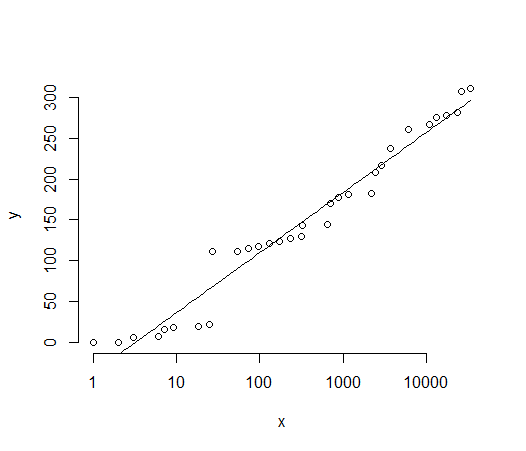Using a logarithmic regression tool found at xuru.org ( http://www.xuru.org/rt/LnR.asp#CopyPaste ) and the data from below, the curve of the graph for this data is roughly described by y = 31.78303295ln(x) - 36.17569359, which has an RSS value of 10877.59526. My goal is to find an equation that describes the data accurately enough so that I can then multiply it by some smallish constant and the resulting y value will always be above, yet still reasonably close to, the expected y value.
As it is, the errors for the calculated y values stray (+ or -) from the actual value in a roughly sinusoidal manner. The errors for the data below are as follows:
expected Calculated Error 0 -37.0769275 37.0769275 1 -14.88358987 15.88358987 7 -1.901319596 8.901319596 8 20.29201803 12.29201803 16 25.22764812 9.227648123 19 33.27428831 14.27428831 20 55.46762593 35.46762593 23 65.98574081 42.98574081 111 68.44989621 42.55010379 112 90.64323384 21.35676616 113 100.2959388 14.70406121 118 109.3971665 8.602833487 121 118.5256062 2.474393843 124 127.5499778 3.549977828 127 137.1795899 10.17958994 130 146.9062597 16.9062597 143 148.3072802 5.307280243 144 170.2548897 26.25488974 170 172.8139194 2.813919413 178 179.674946 1.674946009 181 188.876822 7.876821965 182 209.6750859 27.67508586 208 212.9576731 4.957673121 216 218.3963188 2.396318798 237 226.0826215 10.91737846 261 242.3657911 18.63420891 267 260.7888986 6.211101379 275 266.8441652 8.155834795 278 276.0074897 1.992510289 281 285.2181035 4.218103464 307 289.1736918 17.8263082 310 297.2291502 12.77084978
Bearing in mind that I know very little about statistics, my questions are:
Why is it that when I add more data points the RSS value becomes worse? e.g. the next data point following "34239 310" is "35655 323". When added to the set below and regression is done on the updated set, I get y = 32.38336295 ln(x) - 38.48210346 with RSS=11417.26182.
As the value of x increases, the results become increasingly inaccurate (namely, y consistently falls well below the target value). How should I interpret this?
Given that the errors seem to fluctuate in a sine-like manner, is there some way to use this knowledge to improve the results of the function?
data set: 1,0 2,1 3,7 6,8 7,16 9,19 18,20 25,23 27,111 54,112 73,115 97,118 129,121 171,124 231,127 313,130 327,143 649,144 703,170 871,178 1161,181 2223,182 2463,208 2919,216 3711,237 6171,261 10971,267 13255,275 17647,278 23529,281 26623,307 34239,310
Edit by @PeterEllis - addition of illustrative plot showing the original fit

